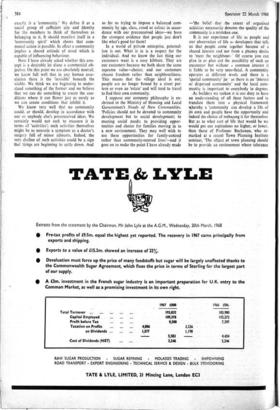Building a community
BUSINESS VIEWPOINT NEIL WATES
We at Wates are in the housing' business; the business of housing people; we know very well that if we are to stay in business for the long term we really must understand the arti- culate and the inarticulate demands of our customers. Since it is inevitable that we can- not satisfy all their demands: we must cer- tainly compromise; but we must do so in the full knowledge of all the constraints upon us and a proper weighting of all the factors.
Neil Wales is the managing director of Wales Limited.
What are . these. constraints? What do people really want from their 'physical frame- work'? Privacy without isolation; freedom from noise yet access to shops:, freedom from overlooking, yet an opportunity' to meet one's neighbours on one's own terms; safety for children to play in (freedom from adults when playing) yet handy access to motor-car from one's house—and all these factors within pre- determined concepts of 'value for money' and certainly within very fixed limits of cost. If we are to strike a proper balance between all these factors we must be able to weight them; if we can weight them we should be able to establish a hierarchy of design criteria.
We hear a great deal of talk in this country— and even more in the United States—about com- munity development. The question that at once arises to any professional developer is— how far is this a desirable, let alone a market- able concept? It is vital that we should be quite clear what we are talking about—what exactly is a 'community.' We define it as a social group of sufficient size and identity for the members to think of themselves as belonging to it. It should manifest itself in a 'community spirit' which shows that com- munal action is possible. In effect a community implies a shared attitude of mind which is capable of influencing behaviour.
Now I have already asked whether this con- cept is a desirable let alone a commercial ob- jective. On this point we are absolutely neutral; we know full well that in any human asso- ciation there is the 'invisible' beneath the visible. We think we are beginning to under- stand something of the former and we believe that we can do something to create the con- ditions where it can flower just as surely as we can create conditions that inhibit it.
We know very well that no community could, or should, develop in accordance with our or anybody else's preconceived ideas. We certainly would not seek to measure it in terms of 'activities'; such activities themselves might be as neurotic a symptom as a doctor's surgery full of minor ailments. Indeed, the very decline of such activities could be a sign that things are beginning to settle down. And as for us trying to impose a balanced com- munity by age, class, creed or colour in accor- dance with our preconceived ideas—we have the strongest evidence that people just don't like what's good for them!
In a world of private enterprise, paternal- ism is out. What is in is a respect for the individual. And we know the last thing our customers want is a cosy kibbutz. They are our customers because we both share the same supreme value—choice; and our customers choose freedom rather than neighbourliness. This means that the village ideal is out; people are no longer bound by a street pat- tern or even an 'estate' and will tend to travel to find their own community.
I suppose our company philosophy is en- shrined in the Ministry of Housing and Local Government's Needs of New Communities. 'Policies should not be devoted to community development but to social development; to meeting social needs; to providing oppor- tunities and choice for families moving in to a new environment. They may well wish to use these opportunities for family-centred rather than community-centred lives'—and it goes on to make the point I have already made
—`the belief that the extent of organised activities necessarily denotes the quality of the community is a mistaken one.
It is our experience of life as people and our observation of life as developers that tells us that people come together because of a shared interest and not from a phoney desire to 'meet the neighbour., ' Of course you can plan in or plan out the possibility of such an encounter but without d common interest it is liable to be very superficial. A community operates at different levels and there is a 'spatial community' jut • as there is an 'interest or dispersed community' and the local com- munity is important to everybody in degrees.
As builders we reckon it is our duty to have an understanding of all these factors and to translate them into d physical framework whereby a 'community can develop a life of its own and people have the opportunity and indeed the choice of reshaping it for themselves But as to what sort of life that would be we would put our aspirations no higher, or lower, than those of Professor Buchanan, who re- marked at a recent Town Planning Institute seminar, 'The object of town planning should be to provide an environment where tolerance
and compassion can flourish'—except possibly that we would add 'with a maximum degree of involvement by those living in it.'








































 Previous page
Previous page